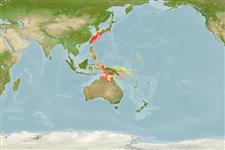Environment: milieu / climate zone / depth range / distribution range
Ecologia
marino demersale; distribuzione batimetrica 10 - 200 m (Ref. 11230). Temperate; 35°N - 21°N, 119°E - 170°E
Northwest Pacific: from the South China Sea north to the Boso Peninsula, Pacific coast of central Japan; not yet recorded from Borneo or the Philippines.
Size / Peso / Age
Maturity: Lm ? range ? - ? cm
Max length : 15.0 cm SL maschio/sesso non determinato; (Ref. 559)
Inhabits the rocky littoral and sublittoral zones of northern Taiwan (Ref. 39597). Found on sandy mud or gravel bottom (Ref. 559).
Life cycle and mating behavior
Maturities | Riproduzione | Spawnings | Egg(s) | Fecundities | Larve
Masuda, H., K. Amaoka, C. Araga, T. Uyeno and T. Yoshino, 1984. The fishes of the Japanese Archipelago. Vol. 1. Tokai University Press, Tokyo, Japan. 437 p. (text). (Ref. 559)
IUCN Red List Status (Ref. 130435)
Threat to humans
Harmless
Human uses
Strumenti
Special reports
Download XML
Fonti Internet
Estimates based on models
Preferred temperature (Ref.
123201): 15.3 - 25.4, mean 21.4 °C (based on 35 cells).
Phylogenetic diversity index (Ref.
82804): PD
50 = 0.5078 [Uniqueness, from 0.5 = low to 2.0 = high].
Bayesian length-weight: a=0.01023 (0.00444 - 0.02358), b=3.01 (2.82 - 3.20), in cm total length, based on LWR estimates for this (Sub)family-body shape (Ref.
93245).
Trophic level (Ref.
69278): 3.8 ±0.7 se; based on size and trophs of closest relatives
Resilienza (Ref.
120179): Medio, tempo minimo di raddoppiamento della popolazione 1.4 - 4.4 anni (Preliminary K or Fecundity.).
Fishing Vulnerability (Ref.
59153): Low vulnerability (10 of 100).
